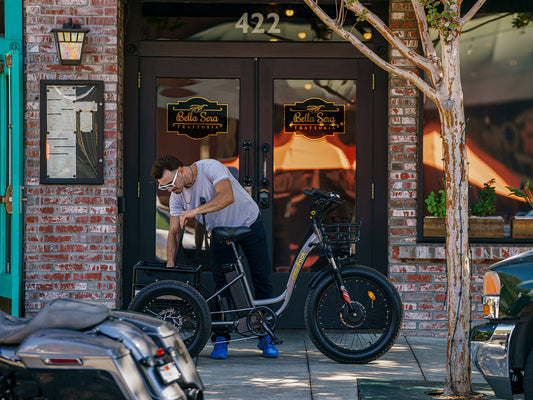Cars use transmission gears for smooth speed changes. Similarly, bikes, including electric bikes, have a gearing system. This system includes sprockets, chains, and a key component: the derailleur.
This system is advanced, but can still face issues like chain loosening and hesitant shifting, though less frequently than traditional bikes. To solve these issues, you need to first know how a derailleur works.
This article examines the derailleur’s role in e-bike performance. We'll explore its function and impact on your ride.
What Is the Function of the Derailleur System?
Derailleurs are like the bike’s gear managers. They work with the chain and sprockets (the toothed wheels) to move the chain from one sprocket to another. This helps change the bike's gears.
In e-bikes, derailleurs are even more important because they work with the extra power of the motor. They ensure the bike shifts gears smoothly and keeps the chain tight, even with the extra force from the motor. Some e-bikes have special electronic derailleurs that can shift gears automatically.

Image Credits: REI
An ebike normally has two derailleurs on it: the rear derailleur and the front derailleur. However, for drive train simplicity, some manufacturers skip the front one for road bikes.
Rear Derailleur
The rear derailleur has two main jobs: keeping the chain tight and changing gears. It adjusts its position to keep the chain tight, no matter which gear you're in. If the chain moves to a bigger sprocket, the derailleur loosens the tension because the chain wraps more around the sprockets. If the chain goes to a smaller sprocket, the derailleur tightens the tension because the chain gets looser.
Front Derailleur
The front derailleur works in a similar way but it’s for the chainrings near the pedals. It moves the chain between these bigger rings. This helps change how hard or easy it is to pedal, especially when going up hills or riding fast on flat roads.
Rear Derailleur: Construction and Working
The rear derailleur is a complex unit and has more role in smooth pedaling. It is placed below the rear cassette and attached to the e-bike's frame via a mounting bolt on the derailleur hanger.

Image Credits: Park Tool – YouTube
The derailleur consists of a parallelogram linkage system connecting the upper and lower pivots, which helps in guiding the chain.

Central to the derailleur’s operation are two pulleys: the Tension Pulley (T-pulley) and the Guide Pulley (G-pulley).
The T-pulley is located at the bottom. It maintains tension in the lower section of the chain. The G-pulley, positioned at the top, is responsible for guiding the chain onto the correct sprocket.

The Working
In traditional bikes and some ebikes, the derailleur is controlled by a cable whose one end is connected to a shifting toggle on the handlebar and the other to the rear derailleur. When activated, the parallelogram linkage moves diagonally, shifting the cage and pulleys. The guide pulley directs the chain to the desired sprocket, adjusting the chain's tension accordingly.
In these bikes, an indexed shifter moves the cable in small pre-determined increments with each click. This process is called indexing.

Some e-bike derailleurs are also controlled electronically. An electrical signal, usually triggered by a button on the handlebar, activates a motor within the derailleur, causing it to move and shift gears.
How to Adjust Rear Derailleur?
The functionality of an e-bike's derailleur can be fine-tuned using various adjusters:
The Barrel Adjuster is used for minor adjustments to the cable tension. This affects how the G-pulley aligns with the sprockets.

Limit Screws (left and right) define the maximum inward and outward travel of the derailleur. They prevent the chain from derailing.

B-Screw controls the gap between the guide pulley and the sprockets, crucial for smooth gear shifting.
Front Derailleur: Construction and Working
The front derailleur is mounted to the bicycle’s frame using a clamp or bracket. This positioning is crucial for its operation, aligning it with the chainrings
Then, there’s a cage, a box-like structure that surrounds the chain. The cage's movement guides the chain to different chainrings. Similar to the rear derailleur, the front derailleur uses a parallelogram linkage. This system ensures that the cage moves in a linear path, parallel to the chainrings.

Mechanical derailleurs are operated by a cable. When the shift lever is activated, it pulls the cable, moving the linkage and thus the cage. A spring mechanism moves the cage back when the cable tension is released. In more advanced setups, a small motor moves the cage. This type of derailleur provides more precise and quicker shifting.
Modern bike chainrings have special parts called shift ramps. They help move the chain to the right gear. When shifting to a smaller gear, the front part of the derailleur pushes the chain until it moves to the smaller gear

Like the rear one, we also have Left and right limiting screws in the front derailleur. The H-screw stops it from moving too far outward, and the L-screw stops it from moving too far inward. This makes sure the chain stays on the gears.
Some front derailleurs let you adjust how high or low the derailleur sits, and how it angles towards the gears. Usually, it should line up straight with the gears. But some special types, like Direct Mount systems, don't let you change the angle.
What Derailleur does Maxfoot Bikes Use?
At Maxfoot, we source everything from high-quality manufacturers. Shimano is the leading name in bicycle components. We use Shimano M310 7-speed derailleur in our ebikes. It is well-known in the market for its rigidity and precise shifting. This choice reflects our commitment to providing riders with reliable, high-performance electric bikes, which ensure a smooth and enjoyable journey every time.
Discover the perfect blend of innovation and quality with Maxfoot, and elevate your e-biking journey to new heights. Explore our range of ebikes and join the Maxfoot riding community. Your adventure awaits!




